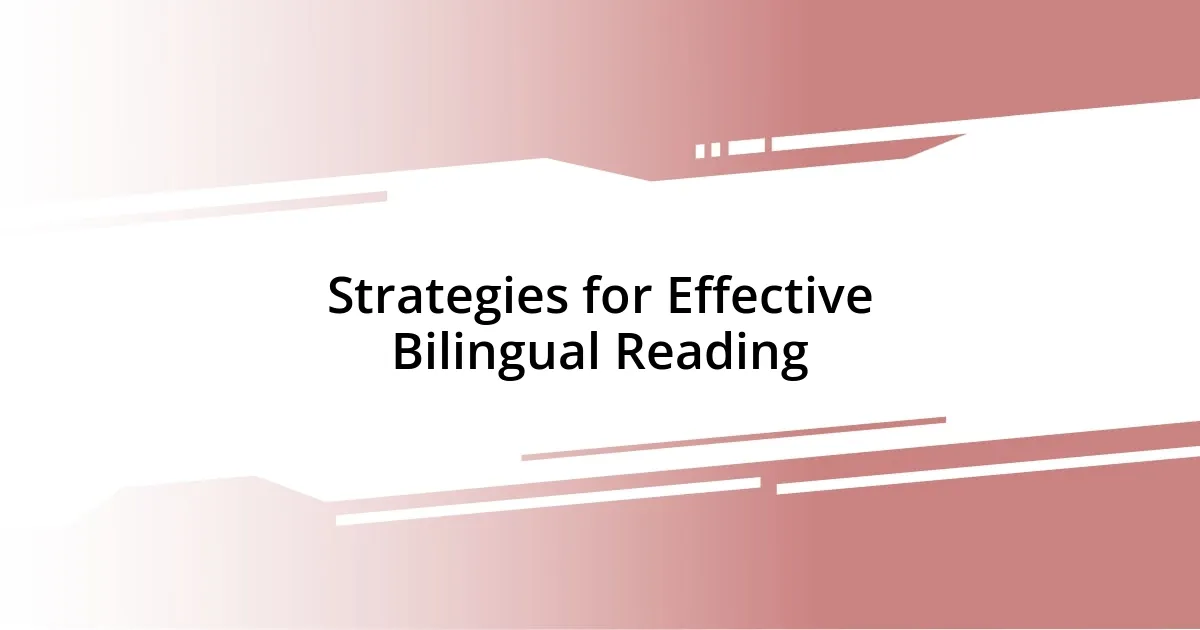Key takeaways:
- Bilingual reading enhances cultural understanding, cognitive flexibility, and emotional connections with texts.
- Choosing the right bilingual books involves considering language balance, age appropriateness, and cultural relevance.
- Effective strategies include setting clear reading purposes, alternating languages based on text complexity, and keeping a bilingual journal.
- Bilingual skills have real-life applications, improving personal interactions, professional opportunities, and volunteer experiences.

Benefits of Bilingual Reading
Bilingual reading opens up a world of cultural understanding that you might not experience otherwise. I remember picking up a bilingual edition of a classic novel; not only did I improve my language skills, but I also discovered layers of meaning that were deeply tied to the cultural context. Have you ever felt that thrill when you realize that words in one language carry a different weight in another?
Another significant benefit is cognitive flexibility. Research shows that juggling two languages can enhance problem-solving skills and creativity. Personally, I’ve found that reading in two languages allows my brain to connect ideas in unexpected ways. Isn’t it fascinating how switching between languages can lead to new perspectives on familiar topics?
Finally, bilingual books can strengthen emotional connections with the text. I once read a heartfelt poem in both my native language and English, and it opened my eyes to the nuances of emotion that might be lost in translation. Have you ever felt that a phrase just resonates differently depending on the language? It’s those moments that make bilingual reading not just an educational tool, but a rich emotional experience.

Choosing the Right Bilingual Books
When it comes to selecting the right bilingual books, personal interests play a pivotal role. I’ve often found that my choice is influenced by themes or stories that resonate with me. It’s like picking a companion for a journey—you want something that makes you excited to explore. Consider books that not only match your language skills but also your passions. Here are some factors I recommend considering:
- Language Balance: Ensure both languages are presented evenly, allowing for better comparison and understanding.
- Age Appropriateness: Choose books that suit your reading level but also align with your interests; this keeps you engaged.
- Cultural Relevance: Look for stories that offer insights into cultures you want to understand better.
- Visual Appeal: Illustrations and layouts can greatly enhance your reading experience, especially with children’s books.
- Recommendations from Trustworthy Sources: Seek out reviews or suggestions from others who share your enthusiasm for languages.
It’s also essential to sample the text before diving in. I vividly recall thumbing through a bilingual storybook featuring folklore from my childhood. Just a few pages in, I felt a rush of nostalgia mixed with excitement about the new language. Sampling a few lines helps to ensure that the style and language resonate with your personal taste and learning preferences.

Strategies for Effective Bilingual Reading
I’ve found that setting a purpose for your bilingual reading can significantly enhance your experience. For instance, I often read to improve my vocabulary in both languages. Sometimes, I focus on comprehension in one language while using the other for context. It’s like having a secret companion that quietly supports your learning. Have you ever noticed how clear objectives bring a sense of direction when you read?
Another effective strategy is to alternate your reading language based on the complexity of the text. I remember starting a bilingual book in my second language and switching back to my native language when the story got complicated. This method not only boosted my understanding but also kept the flow of reading enjoyable. It made me realize that language can sometimes feel like a dance; knowing when to lead and when to follow is key.
Lastly, it helps to keep a bilingual journal to reflect on what you’ve read. After finishing a chapter, I jot down thoughts in both languages. This practice solidifies my understanding and offers a chance to engage with the text on a personal level. Have you ever tried taking notes in multiple languages? It’s an exhilarating process that deepens your emotional connection and enhances retention.
| Strategy | Description |
|---|---|
| Set a Purpose | Establish clear goals for your reading, such as improving vocabulary or comprehension. |
| Alternate Languages | Switch languages based on the complexity of the text to maintain enjoyment and understanding. |
| Bilingual Journal | Keep a journal to document thoughts and reflections on the text in both languages for deeper engagement. |

Enhancing Vocabulary Through Bilingual Books
Reading bilingual books has truly transformed how I approach vocabulary enhancement. I remember diving into a bilingual novel about friendship that unfolded in both English and Spanish. It was fascinating to see the nuanced differences in expression between the two languages. Have you ever stopped to marvel at how some phrases just don’t translate perfectly? That’s where I found the magic—discovering synonyms or alternate phrases in the second language expanded my vocabulary beyond what I initially knew.
One of the things I love most is how bilingual books introduce me to contextually rich language. I can still recall the thrill when I came across a beautifully crafted line in my second language that not only taught me a new word but also illustrated the culture behind it. It’s like each new word adds a small puzzle piece to the bigger picture of understanding. Do you feel the same rush when you finally grasp a word you’ve struggled with? Those “aha!” moments are like little victories in my language journey.
I’ve also found that reading aloud from bilingual books can dramatically enhance my vocabulary retention. The rhythm of speaking the words helps engrain them in my memory. I remember reading a gripping tale late at night and, halfway through, beginning to recite sentences out loud. It felt energizing! It’s funny how I often catch myself thinking, “Why don’t I do this more often?” That blend of auditory and visual learning is a powerful tool—one that can turn learning into an engaging experience rather than a chore.

Measuring Progress in Bilingual Reading
Tracking progress in bilingual reading can be an exciting journey. I remember the first time I finished a bilingual book and felt that blend of accomplishment and curiosity about the words I’d learned. How do you measure your own growth in language comprehension? For me, it was often about noticing the subtle shifts in my ability to grasp idioms and cultural references that once flew over my head. Each book marked a milestone, revealing how far I’d come.
One effective way I gauge my progress is through vocabulary retention checks. I take time after completing each book to list all new words I encountered, then test myself on them. There were instances where I’d think, “Did I really learn this?” and then recall it effortlessly in conversation a week later. It’s surreal to see how those words, once foreign, now weave seamlessly into my everyday dialogue, isn’t it? This method not only reinforces my learning but also provides concrete evidence of my development.
Additionally, I find that reflecting on my emotional reactions to the stories is revealing. When I first started reading bilingual books, I stumbled through passages, feeling frustrated. But as my fluency grew, I began to connect more deeply with the emotional arcs of the characters. Have you ever noticed how much easier it is to empathize with characters when you fully understand their journeys? This transformation, from struggling to engaging, is perhaps the most profound indicator of my progress in bilingual reading.

Real-Life Applications of Bilingual Skills
I’ve come to realize that bilingual skills have significant real-life applications that extend beyond just reading. I remember a time when I was traveling in Spain and had the chance to converse with locals in their native tongue. Those moments of connection stood out for me, as I felt the warmth of their smiles when I made an effort to speak Spanish. Have you ever experienced that delightful rush of being understood in a different language? It’s a feeling of belonging, breaking barriers that otherwise exist.
In a professional setting, being bilingual has opened doors I never anticipated. I once found myself in a meeting where a client preferred communication in French. I distinctly recall feeling a sense of empowerment when I switched from English to French effortlessly. Not only did I build rapport quickly, but I also strengthened my confidence in those moments. Can you think of situations where language has transformed a business interaction for you?
Additionally, my bilingual skills often lend themselves to volunteer opportunities in diverse communities. I’ve participated in programs that connect people to resources, and I often serve as a translator. There’s something special about helping others navigate services in their preferred language. I still remember a mother I assisted who was anxious about filling out a form. Seeing her relief when I helped her understand each question wasn’t just rewarding; it reminded me of how language can empower people. Have you encountered moments where your language skills have made a real difference in someone’s life?













